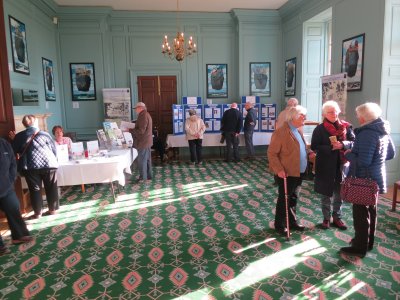On 11 November, Richard Dudding unveiled many surprises in the history of Radley Large Wood: monks, deer, riots, a projected canal and a ‘mist of bluebells’.
The wood was Abingdon Abbey’s deer park, supplying the monks with venison, other game, timber, and fuel. It has the characteristic rounded shape of a woodland deer park, and traces remain of the ditches cleverly designed to make it easy for deer to jump in, but not get out again. In about 1260 the Abbey appointed ‘John Parcarious and his heirs’ as park keepers. But the Abbot seemed to fear that the Parker family would turn poachers. Two keys were simultaneously required to open the wood’s main gate: one held by the keeper, and one for the Abbey’s bailiff to check what the keeper was bringing out.
Around 1350, members of the Parker family were named as ringleaders of riots in Abingdon, and depredations in the deer park. The Abbey tightened the Parkers’ contract, requiring the keepers to swear an oath of loyalty to the Abbot. In 1387 the Abbey won a court case against King Richard II, who had claimed that he had the right to appoint the park keeper.
Following the dissolution of the monasteries, the Abbey’s estates were sold. In 1547, a survey included the ‘separate wood’ then known as ‘Radley Parke’, including 200-year old oaks and an underwood of ash and willow saplings, coppiced every 7 to 10 years.
In 1560, George Stonhouse bought Radley Manor. The Stonhouse family kept the Large Wood for timber and game, and made a separate ornamental deer park near the manor house. From 1671, the Game Laws entrenched hunting as a privilege of the gentry, and there were severe fines for poaching.
In 1795, Radley Manor passed to the Bowyer family, who were a bankruptcy waiting to happen. One of their disastrous ventures was a project for a canal from Bayworth quarry, taking a huge loop southwards into what is now north Abingdon, continuing northwards to Radley Large Wood, and then descending to the Thames at Sandford. The wide ditch still visible at the western edge of the wood could be the result of excavations for this canal.
In 1883 the third Sir George Bowyer died, the creditors pounced, and the estate was again for sale. In 1900 Josephine Dockar-Drysdale purchased it. In the economic depression of 1930, her son William could not find a buyer for the estate, including the wood, which was advertised as a ‘mist of bluebells’ which could make an ‘admirable timbered building estate’. In 1938 her grandson Bill set up a holiday camp for boys in the wood, later becoming a home for wartime evacuees. In the 1950s he opened a new camp, this time for family holidays. Pat Groser came from London to stay, and liked it so much that she moved in as secretary. Supporters of Halifax rugby league team made it a regular stopover on their journeys to the league final at Wembley.
The wood now includes three sylvan mobile home parks. The Parish Council’s adopted neighbourhood plan notes that the Council would oppose their conversion to other uses. The wood is classified as ‘ancient semi-natural woodland’, and hugely appreciated by local walkers. Sadly, its tranquillity might be threatened by one possible route of the proposed ‘expressway’. The church’s heating worked perfectly, and a large audience overflowed into the gallery. You can read more about the wood and Radley Manor in the History Club’s book, Radley Manor and Village, on sale in the village shop or from the Club’s website.


